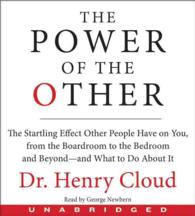Full Description
Available to healthcare professionals for the first time, this book contains proven screening tests to measure neuromotor immaturity in children and adults in order to provide a basis for referral and help.
Allows practitioners to screen for disorders of movement that can negatively affect educational performance and emotional function in children and adolescents
Assesses instances where disorders of movement in adults are affecting thoughts and behavior, as in panic disorder
Provides a novel approach for health care professionals observing aberrant reflexes in the absence of more serious pathology
Includes reproducible scoring and observation sheets for practice and serves as the perfect complement to Assessing Neuromotor Readiness for Learning
Contents
Foreword x
Dr Arthur Paynter
Acknowledgements xiii
1 Identifying Signs of Neuromotor Immaturity in Children and Adults 1
1.1 Introduction 1
1.2 How to use this Manual 2
1.3 Overview 3
1.4 Relationship between Neuromotor Immaturity and Learning Outcomes 4
Literature review 4
1.5 Neuromotor Immaturity in Adolescents 6
1.6 Relevance of the INPP Screening Test to Health Practitioners 8
1.7 What is the INPP Method? 8
Why assess posture and balance? 9
Why carry out assessments for balance? 9
What is the significance of static balance and dynamic balance to learning? 10
What is the significance of postural control to learning? 10
What is the link between primitive reflexes, balance and postural control? 11
1.8 How Does the Vestibular System Work? 11
1.9 Primitive Reflexes 12
Why have these four reflexes been selected for evaluation? 12
1.10 What Evidence is there that Intervention in the Form of Movement Programmes Aimed at the Level of Primitive Reflexes Improves Reflex Status and Educational Outcomes? 18
1.11 What was known about Exercises to Inhibit Primitive Reflexes? When was the INPP Method Developed? What has been your Personal Experience Since then? 19
1.12 What is the Difference between the INPP Method, Sensory Integration (SI), Vojta Therapy, Bobath Therapy and Others Working with Primitive Reflexes? What are the Criteria for Referral to a Particular Therapy? 20
The INPP method 20
Sensory Integration (SI) therapy 21
Vojta therapy 22
Bobath therapy 26
1.13 What are the Top Five Medical Diagnoses Where Referral to INPP Should Routinely be considered After Checking the Reflexes by Clinicians? 27
1.14 Screening Tests 27
How to use the screening test 28
References 28
2 Screening Test for Use with Children 32
2.1 General Instructions 32
2.2 Scoring 32
2.3 Tests 33
The Romberg test 34
One-leg stand or Unipedal Stance Test (UPST) 37
Tests for 'soft signs' of neurological dysfunction: The Tandem and Fog walks 39
The Tandem walk 40
The Fog walk (1963) (walking on the outsides of the feet) 42
Finger and thumb opposition test 44
2.4 Tests for Primitive Reflexes 46
Asymmetrical Tonic Neck Reflex (ATNR) 46
Test procedure: Ayres quadruped test for the ATNR 47
Adapted Hoff-Schilder test for the ATNR (from seven years of age) 48
The Symmetrical Tonic Neck Reflex (STNR) 50
Tonic Labyrinthine Reflex (TLR): Erect test 52
The Moro reflex 54
2.5 Sample Score Sheets 56
2.6 Sample Observation Sheets 57
2.7 Interpreting the Scores 58
Children 58
References 59
3 Neuromotor Immaturity in Adults 61
3.1 The Role of the Vestibular System and Its Connections 61
3.2 Historical Background to Links between Vestibular-Cerebellar Dysfunction and Anxiety, Agoraphobia and Panic Disorder 64
3.3 Vestibular Dysfunction: Cause or Effect? 68
3.4 Rationale for a Somatogenic/Psychosomatic Basis to Some Anxiety Disorders 68
3.5 Postural Righting Reactions 71
Labyrinthine Head Righting Reflexes (LHRRs) 71
3.6 The Moro Reflex: A Trigger for Panic? 72
3.7 How to Use the INPP Screening Test 74
3.8 The INPP Adult Screening Questionnaire 76
3.9 Interpreting the INPP Adult Screening Questionnaire 79
References 80
4 INPP Screening Test for Signs of Neuromotor Immaturity in Adults 83
4.1 General Instructions 83
4.2 Scoring 83
4.3 Screening Tests for Use with Adults 83
4.4 Tests for Balance and 'Soft Signs' of Neurological Dysfunction (ND) 84
4.5 Tests for Balance and Proprioception 86
The Romberg test 86
The Mann test (advanced Romberg test) 89
The tandem walk 91
The Fog walk (1963) (walking on the outsides of the feet) 93
4.6 Tests for Primitive Reflexes 95
Asymmetrical Tonic Neck Reflex (ATNR) 95
Ayres quadruped test for the ATNR 96
Asymmetrical Tonic Neck Reflex adapted Hoff-Schilder (erect) test 97
The Symmetrical Tonic Neck Reflex (STNR) 99
Tonic Labyrinthine Reflex (TLR): Erect test 101
Moro reflex 103
Erect (drag) test for the Moro reflex 105
4.7 Adult screening test 107
4.8 Interpreting the scores 109
References 110
Resources 111
Index 121




